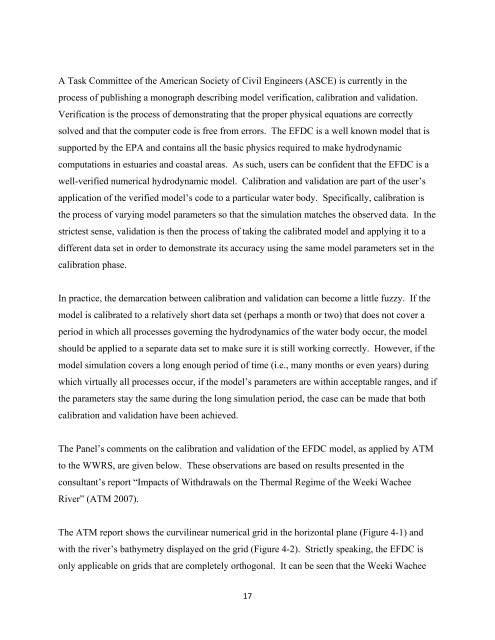Weeki Wachee River System Recommended Minimum Flows and ...
Weeki Wachee River System Recommended Minimum Flows and ...
Weeki Wachee River System Recommended Minimum Flows and ...
You also want an ePaper? Increase the reach of your titles
YUMPU automatically turns print PDFs into web optimized ePapers that Google loves.
A Task Committee of the American Society of Civil Engineers (ASCE) is currently in the<br />
process of publishing a monograph describing model verification, calibration <strong>and</strong> validation.<br />
Verification is the process of demonstrating that the proper physical equations are correctly<br />
solved <strong>and</strong> that the computer code is free from errors. The EFDC is a well known model that is<br />
supported by the EPA <strong>and</strong> contains all the basic physics required to make hydrodynamic<br />
computations in estuaries <strong>and</strong> coastal areas. As such, users can be confident that the EFDC is a<br />
well-verified numerical hydrodynamic model. Calibration <strong>and</strong> validation are part of the user’s<br />
application of the verified model’s code to a particular water body. Specifically, calibration is<br />
the process of varying model parameters so that the simulation matches the observed data. In the<br />
strictest sense, validation is then the process of taking the calibrated model <strong>and</strong> applying it to a<br />
different data set in order to demonstrate its accuracy using the same model parameters set in the<br />
calibration phase.<br />
In practice, the demarcation between calibration <strong>and</strong> validation can become a little fuzzy. If the<br />
model is calibrated to a relatively short data set (perhaps a month or two) that does not cover a<br />
period in which all processes governing the hydrodynamics of the water body occur, the model<br />
should be applied to a separate data set to make sure it is still working correctly. However, if the<br />
model simulation covers a long enough period of time (i.e., many months or even years) during<br />
which virtually all processes occur, if the model’s parameters are within acceptable ranges, <strong>and</strong> if<br />
the parameters stay the same during the long simulation period, the case can be made that both<br />
calibration <strong>and</strong> validation have been achieved.<br />
The Panel’s comments on the calibration <strong>and</strong> validation of the EFDC model, as applied by ATM<br />
to the WWRS, are given below. These observations are based on results presented in the<br />
consultant’s report “Impacts of Withdrawals on the Thermal Regime of the <strong>Weeki</strong> <strong>Wachee</strong><br />
<strong>River</strong>” (ATM 2007).<br />
The ATM report shows the curvilinear numerical grid in the horizontal plane (Figure 4-1) <strong>and</strong><br />
with the river’s bathymetry displayed on the grid (Figure 4-2). Strictly speaking, the EFDC is<br />
only applicable on grids that are completely orthogonal. It can be seen that the <strong>Weeki</strong> <strong>Wachee</strong><br />
17
















